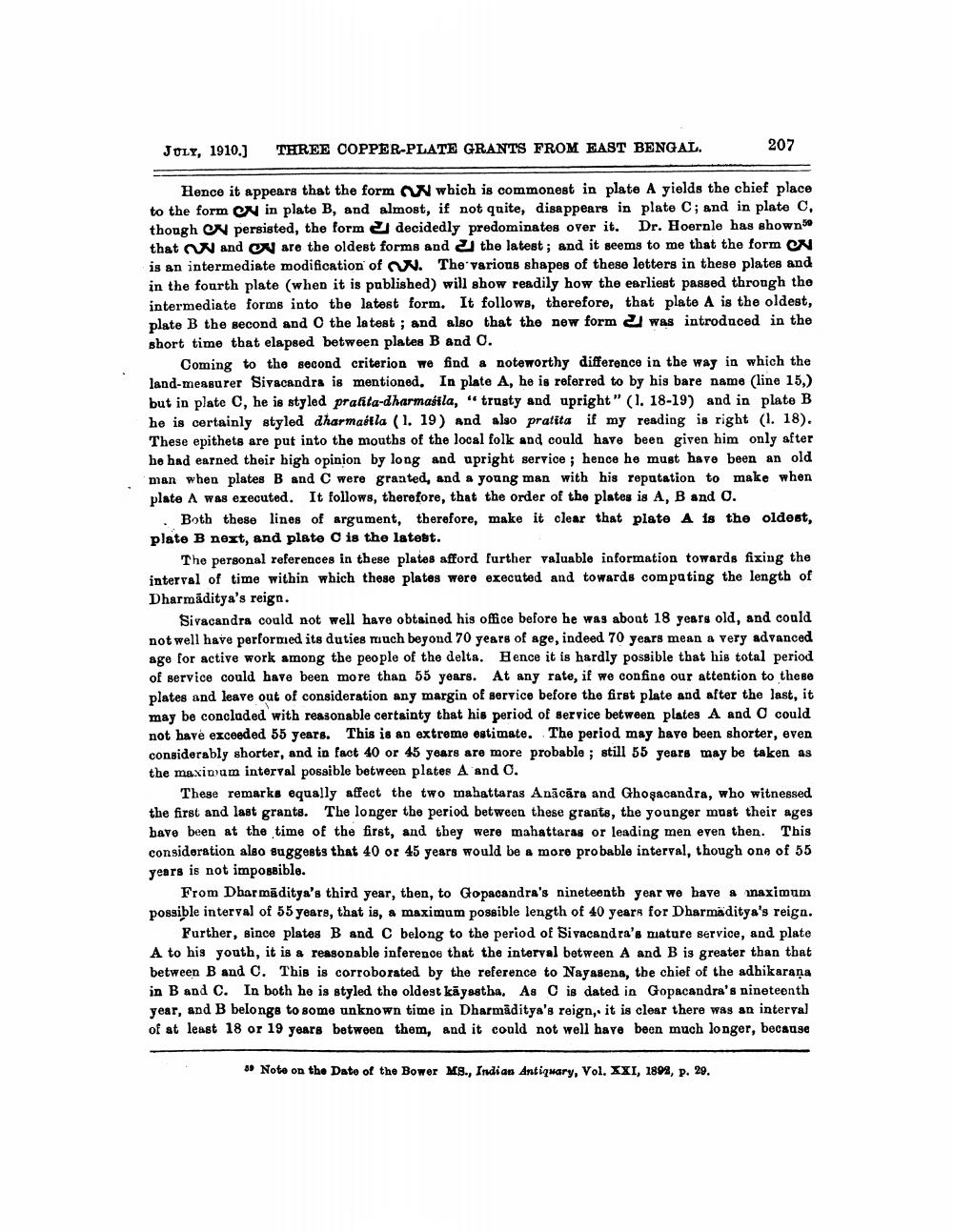________________
JULY, 1910.)
THREE COPPER-PLATE GRANTS FROM EAST BENGAL.
207
Hence it appears that the form which is commonest in plate A yields the chief place to the form av in plate B, and almost, if not quite, disappears in plate C; and in plate C, though a persisted, the form I decidedly predominates over it. Dr. Hoernle has shown that and an are the oldest forms and the latest; and it seems to me that the form is an intermediate modification of W. The various shapes of these letters in these plates and in the fourth plate (when it is published) will show readily how the earliest passed through the intermediate forms into the latest form. It follows, therefore, that plate A is the oldest, plate B the second and the latest ; and also that the new form was introduced in the short time that elapsed between plates B and 0.
Coming to the second criterion we find a noteworthy difference in the way in which the land-measurer Siyacandra is mentioned. In plate A, he is referred to by his bare name (line 15,) but in plate C, he is styled prahita-dharmasila, “trusty and upright" (1. 18-19) and in plate B he is certainly styled dharmailla (1. 19) and also pratita if my reading is right (1. 18). These epithets are put into the mouths of the local folk and could have been given him only after he had earned their high opinion by long and upright service ; hence ho must have been an old man when plates B and C were granted, and a young man with his reputation to make when plate A was executed. It follows, therefore, that the order of the plates is A, B and 0.
. Both these lines of argument, therefore, make it clear that plate A is the oldest, plate B next, and plate is the latest.
The personal references in these plates afford further valuable information towards fixing the interval of time within which these plates were executed and towards computing the length of Dharmāditya's reign.
Sivacandra could not well have obtained his office before he was about 18 years old, and could not well have performed its duties much beyond 70 years of age, indeed 70 years mean a very advanced age for active work among the people of the delta. Hence it is hardly possible that his total period of service could have been more than 55 years. At any rate, if we confine our attention to these plates and leave out of consideration any margin of service before the first plate and after the last, it may be concluded with reasonable certainty that his period of service between plates A and could not have exceeded 55 years. This is an extreme estimate. The period may have been shorter, even considerably shorter, and in fact 40 or 45 years are more probable ; still 55 years may be taken as the maximum interval possible between plates A and O.
These remarks equally affect the two mahattaras Anācāra and Ghoşacandra, who witnessed the first and last grants. The longer the period between these grants, the younger must their ages bave been at the time of the first, and they were mahattaras or leading men even then. This consideration also suggests that 40 or 45 years would be a more probable interval, though one of 55 years is not impossible.
From Dharmāditya's third year, then, to Gopacandra's nineteenth year we have a naximum possible interval of 55 years, that is, a maximum possible length of 40 years for Dharmaditya's reiga.
Further, since plates B and C belong to the period of Sivacandra's nature service, and plate A to his youth, it is a reasonable inference that the interval between A and B is greater than that between B and C. This is corroborated by the reference to Nayasena, the chief of the adhikarana in B and C. In both he is styled the oldest käyastha. As C is dated in Gopacandra's nineteenth year, and B belongs to some unknown time in Dharmaditya's reign, it is clear there was an interval of at least 18 or 19 years between them, and it could not well have been much longer, because
Note on the Date of the Bower MB., Indian Antiquary, Vol. XXI, 1892, p. 29.




